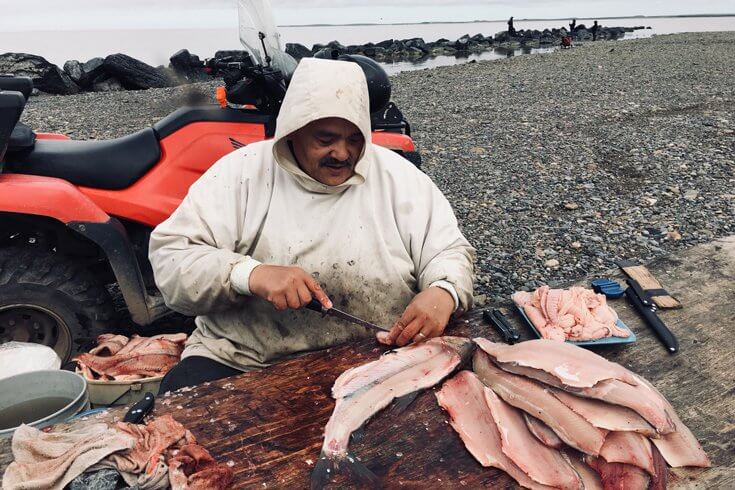As the truck rocked and churned its way through potholes and muck, my sister, daughter, and I laughed. After our nearly fifty-hour drive from Edmonton to Inuvik, Northwest Territories, we were following through with our plan to continue on for another couple of hours to Tuktuyaaqtuuq (officially spelled “Tuktoyaktuk” in English), an Inuvialuit hamlet of about 900 people on the coast of the Arctic Ocean. After so much time on the road, the three of us were giddy from fatigue and excited for what we would find at the end of the highway.
Until recently, you couldn’t drive to Tuktuyaaqtuuq; it was reachable only by boat and aircraft in the summer and by ice road in the winter. But, in November 2017, Highway 10, a new all-weather road commonly known as the Inuvik–Tuktoyaktuk (or Inuvik–Tuk) highway, opened to the public to much fanfare. Last summer, we decided to test it out.
My sister Megan, who is of settler Canadian ancestry and lives in Lashburn, Saskatchewan, sported a grin the whole drive up. She had not been north since we left Inuvik, when she was two years old, twenty-five-odd years ago. My two-year-old daughter, Quinn, on the other hand, has been to Inuvik several times, but the highway was still a novelty, and she found the jolting, jarring nature of this uneven gravel road to be, as she put it, “the best.”
I am originally from Inuvik, so the area that we Dinjii Zhuh (some might know us as Gwich’in) call Nanhkak Thak, or “our country,” is familiar to me. Though I visit home often, this would be my first trip to Tuktuyaaqtuuq as an adult.
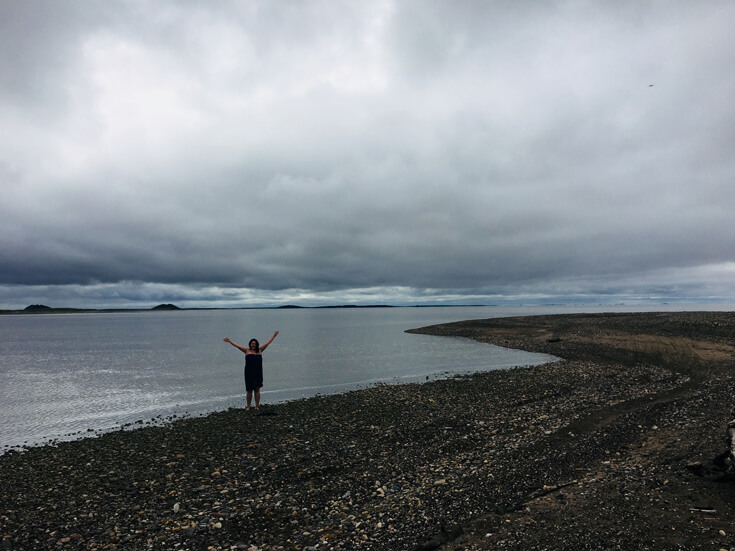
But, for me, this day wasn’t just about playing tourist in my home region. As a historian and mother, I saw travelling the highway as a chance for my family to better understand the culture of our Inuvialuit neighbours. The Dinjii Zhuh nation is an Athabaskan-speaking group whose homeland crosses parts of what are now the NWT, the Yukon, and Alaska; Inuvialuit, or Inuit of the western Arctic, speak Inuvialuktun—a vastly different language. This region, where the Kuukpak (the Inuvialuktun name for the Mackenzie River) flows into the Beaufort Sea, off the northern coast of the NWT, is where the homes of Dinjii Zhuh and Inuvialuit overlap.
Just like our ancestors, Dinjii Zhuh today have close relationships with neighbouring Indigenous nations: we share communities, become family members, and offer one another teachings and knowledge. I fondly recall learning about Inuvialuit culture and attending Inuvialuktun classes at school with Rosie Albert, one of my language teachers. In 2017, Mollie Oliktoak from Ulukhaktok, a community in eastern NWT, taught me how to cut an atiqaluk (also known as a parka cover) pattern—a skill that Indigenous women of the region and of a certain age are expected to master. For our trip last summer, Quinn and I wore matching atiqaluks made by expert Inuvialuit seamstress Lillian Elias.
Our truck wasn’t the only vehicle bouncing up the road. We passed several RVs, likely those of tourists from down south. The government of the NWT markets the highway as a “milestone” and “the first road in history to reach the polar shore of North America.” The federal government, for its part, has linked the road’s opening with persistent and troublesome narratives of nation building, heralding it as connecting all Canadians “from coast to coast to coast.” I wondered how many of those tourists saw the highway that way—as simply an avenue to the Arctic Ocean, a handy bucket-list adventure. To me, and to those who live on either end of the highway, the new road is about connecting with ourselves.
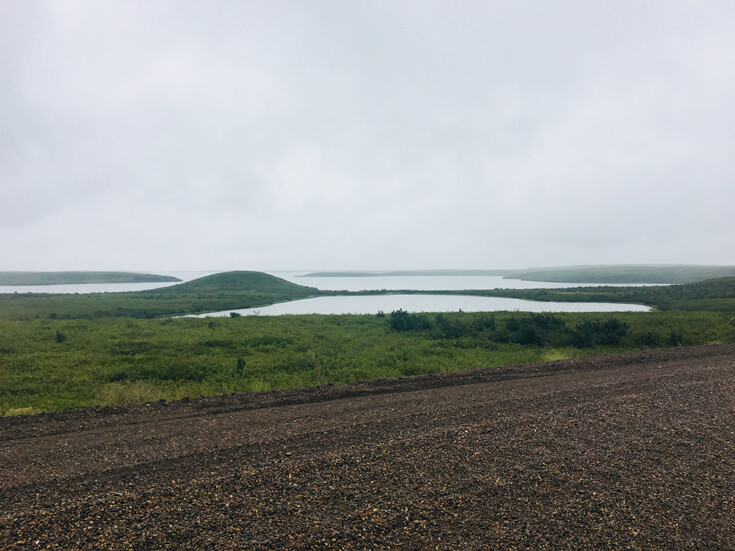
Before the trip, I’d seen stunningly beautiful drone images taken by Inuvik-based photographer Kristian Binder. But seeing up close the rich greenery, vast assortment of birds, and captivating pingos (small hills of earth-covered ice) that had filled my elementary-school colouring sheets was breathtaking. There is something special about witnessing the ways Indigenous peoples care for their lands that you can’t get from photos or documentaries.
A version of the road was originally proposed as a component of prime minister John Diefenbaker’s Roads to Resources program during the late 1950s and early 1960s, a time when the federal and provincial governments were actively disrupting Indigenous lifestyles, economies, and politics through forced assimilation. The road was meant to support oil-and-gas development, but resource-extraction projects were stalled for decades, and it wasn’t until 2011 that prime minister Stephen Harper committed $150 million to fulfill Diefenbaker’s dream. (Two years later, the government’s commitment rose to $200 million, roughly two-thirds of the project’s total cost.) The message remained much the same as when the road was first envisioned: an all-season highway would help connect the Arctic coast with the rest of Canada.
To me, the coast-to-coast-to-coast framing of national unity erases Indigeneity by overlooking ongoing Indigenous land ownership and modern treaty negotiations and agreements. If building the road was intended solely to help Canadians reach the Arctic coast more easily, with little regard for the people living there, that would implicitly make our lands less Indigenous and more Canadian.
This doesn’t mean that Indigenous people never wanted the highway, but it does mean we had our own vision for it. The colonial perspective makes it easy to overlook the role of Tuktuyaaqtuuq residents, local business owners, and Dinjii Zhuh and Inuvialuit politicians and lobbyists who advocated for the highway—and what it should look like and who should build it—over the past several decades. For them, the road was not about celebrating a colonial vision. An all-weather highway had practical, immediate benefits: local Indigenous-owned businesses won the contract to build the highway, and its construction would not only help reduce food insecurity but also inject much-needed work into local economies, including tourism.
Coming from a northern community, I can appreciate having permanent access to better-priced groceries, fuel, supplies, and services such as health care, as well as the flexibility of road travel: you no longer need to wait for the next flight to leave town. In that way, the highway is also a symbol of the autonomy that Indigenous peoples have long been denied. Before the road officially opened, resident Joe Nasogaluak suggested that the name of the highway should commemorate three Inuvialuit boys who fled Stringer Hall, an Inuvik residential school. In 1972, Bernard Andreason, Lawrence Elanik, and Dennis Dick attempted to walk to Tuktuyaaqtuuq; Andreason was the only survivor. Nasogaluak recommended that the road be named “Freedom Trail,” underscoring that these children were “fighting for their lives, to reach home, for freedom.”
Their story is a reminder that travelling through our lands today is a way to reclaim our education. The road itself has helped people reconnect with the land by making it easier to reach certain hunting areas and lucrative berry patches. Last fall, my social-media feeds were overflowing with photos of pails filled to the brim with beautiful akpiks, known to some as salmonberries or cloudberries. But, unlike some of the tourists I’d run into during the trip last summer, I knew better than to ask locals in Tuktuyaaqtuuq how to reach prized berry-picking spots. Most southerners have a lot to learn about the North—not least how to be a good visitor there.
Our first stop in Tuktuyaaqtuuq was the beach at the end of Beaufort Road, also known as The Point, where the landmark Arctic Ocean sign stands. There were a dozen or more rented vehicles and tourist buses parked and a long lineup at the latrine. Megan and I hoisted ourselves out of the truck, still stiff from driving 3,300-plus kilometres. Quinn, now untethered, sprang from her car seat and sprinted toward the water—an act to get any parent’s heart pounding. I chased her down the beach, fighting through a thick cloud of mosquitoes that dissipated once I reached the water’s edge.
I felt at home walking along the rocky shore and inhaling the summer Arctic air. Although I was on Inuvialuit land—and surrounded by tourists in windbreakers, who liberally applied bug dope and snapped selfies—I was reminded of my family’s fish camp up the Kuukpak, south of Tuktuyaaqtuuq at Dachan Choo Gę̀hnjik, and the emotions that being on the land evoke. As an elder once told me, being on the land is a powerful act. By being on the land, as Indigenous peoples, we are refuting colonial policies that sought to destroy our connections with our lands, but we are also reconnecting with our ancestors, being responsible stewards, monitoring potentially important changes, and satisfying our spirits.
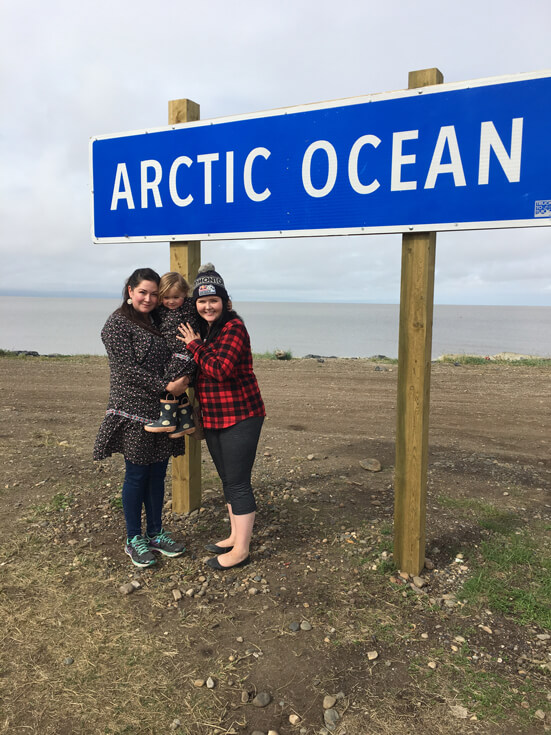
Looking around, I was drawn to a man sitting at a table, working with an abundance of whitefish. Several dozen fish were strewn on the table, stuffed in baskets, and resting on the gravel shore. I walked over and introduced myself. Darrel Nasogaluak, former mayor of Tuktuyaaqtuuq, told me that he had set his fishing nets earlier that morning, and the glistening mass he later returned to was a welcome surprise.
I had not met Nasogaluak before that day, but while chatting, we discovered that he goes geese hunting with a cousin of mine who lives in the nearby community of Tsiigehtchic: an example of persisting Inuvialuit–Dinjii Zhuh relationships. I asked Darrel if he would sell me some of his catch, but he quietly chuckled and directed me to others in town who might have reserves to sell.
I understood his meaning. Cleaning, preparing, drying, and smoking fish requires an immense amount of knowledge and a good deal of practice to get right. Those who know how to prepare dry fish correctly can amass ample stores for the winter, enough to keep several families and their dogs happy and healthy. So, even if a fisherman like Nasogaluak hauls in a big catch, it’s not for being consumed all at once. Part of being a respectful visitor is respecting those boundaries.
A few hundred metres away, toward the parking lot, was a small smoke shack that Nasogaluak suggested we visit. It belonged to his friend, and Nasogaluak invited us to look at the fish through its small open-air window. Smoke shacks can be either permanent or temporary. This one looked like it had been used over several seasons and was built from scrap wood and spare boards. Inside sat a stove or firepit, which, when operating, would require constant attention: the proper type of wood is needed to create the right kind of smoke at just the right temperature; the fire cannot be too hot. Fish hang from wooden poles above, to dry and absorb the smoke.
Dinjii Zhuh call fish that have been preserved in this way “uutsik,” and Inuvialuit call it “pipsi.” In English, the delicacy is known as “dried fish.” I noticed that the filleting and drying techniques displayed at the smoke shack appeared similar to how my family, the Andres and Bullocks, make uutsik, with one exception: the backs and spines of the fish in this hut had been removed before the drying and smoking process, whereas we would leave them on to weigh down the fish. I considered going back to ask Nasogaluak why this technique was used here, but a tourist had caught his attention.
As Megan, Quinn, and I headed back to the parking lot and its dreadful mosquitoes, I recalled the Dinjii Zhuh Ginjik phrase ch’ii shìh (pronounced ch-ee zhee): “mosquito food.” The mosquitoes on that day were vicious beasts. During my master of arts research, I had laughed when I read, in explorer and fur trader Alexander Mackenzie’s journals about his visit to the North during the 1780s, complaints about the mosquitoes and bugs in Dinjii Zhuh and Inuvialuit camps. It turned out that living in the south had softened my ability to tolerate these biting pests; instead of laughing at Mackenzie, I now laughed at myself.
Megan wanted to know what was so funny. “Never mind!” I remember telling her. “Let’s hustle to the sign before we’re eaten alive.” This was Megan’s first time visiting the region, and Quinn and I appreciated her insistence on engaging in all of the touristy activities since that allowed us to see different aspects of Tuktuyaaqtuuq that perhaps Dinjii Zhuh visitors tend to overlook. We made it to the Arctic Ocean sign as we swatted the air around us, then engaged in a feeble attempt to use our selfie stick. An observant tourist saved us from ourselves.
There’s some economic benefit to the new wave of tourism the highway brings to Tuktuyaaqtuuq families, and that, without a doubt, is a good thing. According to recent statistics, the community was on target to see more than 5,000 visitors last summer. That is incredible, considering that only the bravest of (settler Canadian) souls formerly made the trip, in the summertime, by boat or aircraft. After hosting a recent destination wedding, which featured local group Siglit Drummers and Dancers and even made national news, and the launch event for the 2019 Chevrolet Silverado, Tuktuyaaqtuuq is becoming more accessible to the world.
But, as in many tourist destinations, visitors also create friction. Wherever we went in Tuktuyaaqtuuq, I could hear questions such as, “Are you native?” “Do you actually serve traditional foods?” “Where do you get your product?” “Did you, yourself, actually hunt it?” “What sort of food regulations are in place?” “Do you have any crafts in your home for sale?” Gritting my teeth, I watched business owners respond with candour and humour. “Where can I pick berries along the highway?” is a particularly intrusive question. Berry harvesting is an ancient cultural practice for Dinjii Zhuh and Inuvialuit and is directly linked to food security: locals might not appreciate tourists harvesting precious resources.
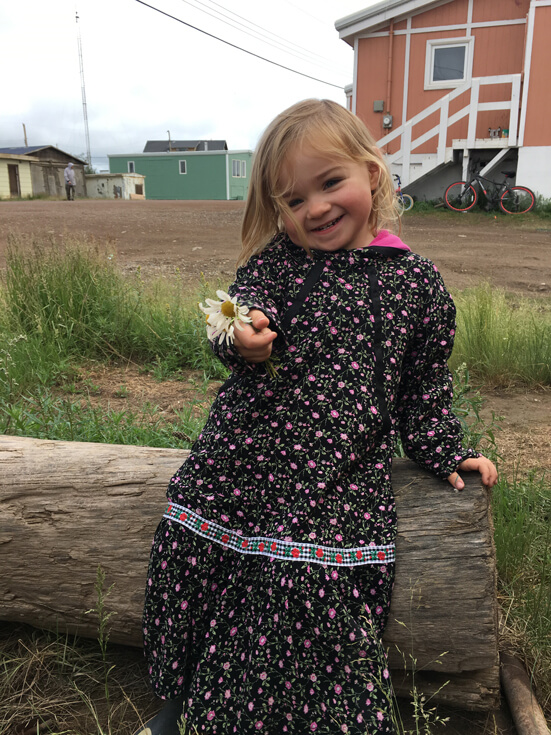
The infractions aren’t limited to breaches of etiquette either. I was deeply unsettled when a tourist photographed my daughter, who was wearing her atiqaluk while playing in the Arctic summer flowers, without permission. There’s an all-too-common notion that Indigenous peoples and their cultures need to be “on display” for settler Canadian audiences. The North has been enveloped in tropes of adventure, advanced by the work of explorers like Mackenzie, for centuries. Many non-Indigenous people still see the North as a place that needs to be “conquered”—except that, now, they do the conquering with RVs, SUVs, and cameras.
But, driving around the community—the pesky mosquitoes having made it unpleasant to walk—I was delighted to see that many of the street signs commemorated Inuvialuit names, streets like Mangilaluk Loop and Uungalak Road. Increasingly, Indigenous peoples are reclaiming place names. That local families are acknowledged and celebrated speaks to the power of the culture and language revitalization that communities are continually embracing.
I doubted I’d be able to secure any whitefish to bring back to Inuvik since it was always in such high demand, but I was willing to settle for other local fare. For lunch, we headed to Beluga Burgers, a pop-up restaurant that, I have since discovered, received a single five-star rating on Yelp—an assessment with which I wholeheartedly agree. We saw the hot BBQ grill standing on call and poked our heads into the canvas tent to find a lineup of homemade akpik tarts, granola bars, bannock, a crockpot of muskox chili, and our choice of muskox burgers or beef smokies. In a no-brainer decision, we ordered muskox chili, a muskox burger, bannock, and an akpik tart to share.
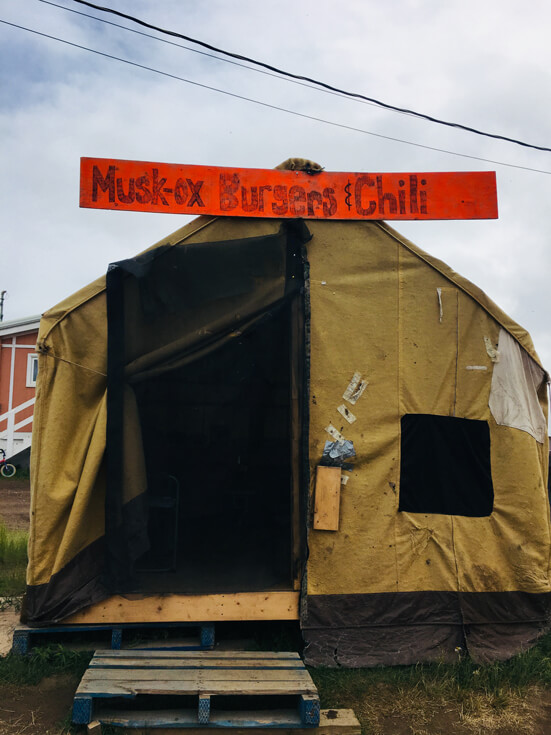
I had to leave room for some maktaaq. Also known as “muktuk,” this delicacy consists of raw whale skin and blubber. And where better to consume maktaaq than in an Inuvialuit community where it’s locally harvested and processed? Of course, this wasn’t my first opportunity to try it. But, about thirty years ago, I fell into a tub of particularly fragrant (and possibly expired) uqsuq, or whale oil, on an elementary-school camping trip. No one had brought an extra pair of ski pants, so I had to wear my uqsuq-infused gear for the remainder of the trip. I had not been able to eat whale products since.
That day last summer, I was finally ready to try the delicacy again. I’m not sure if it was because of the fresh, salty air, because Megan was dipping her toes into the Arctic Ocean for the first time, or because I was simply glad to be back in Tuktuyaaqtuuq—but I knew it was time. We stopped by Grandma’s Kitchen, owned and operated by Joanne Edwards-Steen. Although maktaaq was not on the menu that day, Joanne called for her husband, who prepared a plate of it for us. It was the most delicious, fresh maktaaq I’ve ever had—a delightful blend of fats and salt water with a memorable, pungent fish flavour.
Afterward, with our hearts and bellies full, Megan, Quinn, and I started the drive back to Inuvik. Within minutes, the potholes gently rocked my travel companions to sleep. I hadn’t managed to purchase any fish, but I didn’t mind. I knew I could come back anytime.

